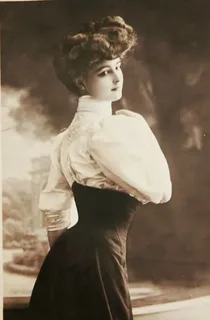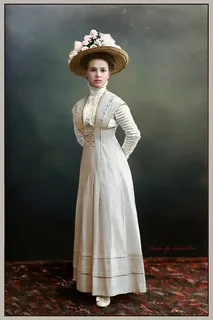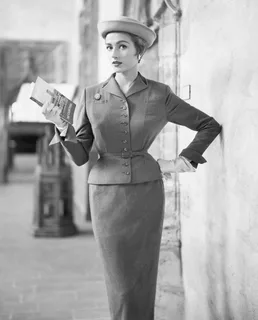1917 Women’s Fashion was more than just clothing; it was a reflection of society, culture, and even the war. Women’s fashion in this era had to strike a balance between elegance and practicality, as the world was in the throes of World War I. As the war affected many aspects of daily life, including fashion, women began to embrace new styles that combined functionality with grace.
In 1917, fashion for women reflected the changing roles they were taking on. No longer confined to the home, women were stepping into the workforce and supporting the war effort, which meant their clothing had to adapt. While fashion didn’t lose its sense of sophistication, it certainly became more practical. Let’s take a look at the key elements of 1917 fashion for women, exploring the details that made it iconic.

The Silhouette: A New Shape for the Modern Woman
1917 Women’s Fashion was drastically different from the hourglass shapes of earlier decades. Gone were the corsets that cinched in the waist. Women’s clothing became looser and more comfortable. The new silhouette was straighter, with a focus on practicality without sacrificing elegance.
The skirt length was also shorter than before. Skirts that fell just above the ankle became more popular, as women needed more mobility. This was partly due to the war, as women were working in factories, driving ambulances, and even taking on roles previously held by men. Fashion had to keep up with this new reality.
The Impact of World War I on Fashion
The First World War had a profound effect on 1917 fashion for women. Resources like fabric were scarce, so women’s clothing became simpler. Heavy ornamentation, like beading or embroidery, was used sparingly. Instead, practicality and minimalism became key.
Due to the war, many women had to make do with what was available, often repurposing old fabrics or altering their existing wardrobes to fit the more streamlined, functional styles. The war also influenced color choices. Darker colors, such as navy, grey, and brown, became dominant as bright, cheerful colors were deemed inappropriate during such somber times.
Coats and Outerwear: A Necessity
Outerwear was an essential part of 1917 women’s fashion. The trench coat became a popular item, inspired by military uniforms. Women wore long, practical coats that were perfect for the cold weather and provided coverage when they stepped outside.
Fur was a popular material for outerwear, especially for collars, cuffs, and even hats. Fur coats were not only stylish but also practical for warmth. Many women would pair their outerwear with matching accessories, such as gloves and hats, to complete the look.
Accessories: Hats, Gloves, and Shoes
Hats were an essential part of 1917 women’s fashion. Women never left the house without a hat, and these accessories came in various shapes and sizes. Cloche hats, which were close-fitting and typically made of felt, were incredibly popular. Wide-brimmed hats were also worn, often adorned with minimal decorations, as wartime shortages limited extravagant details.
Gloves were another must-have accessory. Whether made from leather or fabric, gloves added a refined touch to any outfit. Shoes in 1917 were practical yet stylish, with ankle boots being a popular choice. These boots often had low heels, offering comfort and support for women on the go.
Fabrics and Textures: Functionality Meets Fashion
Due to fabric shortages, 1917 fashion for women saw a shift toward using more durable materials. Wool, cotton, and linen were commonly used in everyday clothing. Silk and other luxurious materials were reserved for special occasions, but even then, their use was limited.
Military influences were seen in the materials as well. Tweed, a fabric traditionally used for men’s suits, was adopted by women for jackets and skirts. This material was hard-wearing and practical, aligning with the needs of the time.
The Rise of Ready-to-Wear
1917 Women’s Fashion roles changed during World War I, the demand for ready-to-wear fashion increased. With less time to sew and fewer resources available, women turned to department stores for their clothing needs. Ready-to-wear garments became more widely available, offering women affordable and stylish options.
This was a significant shift in 1917 fashion for women. Before this period, most women either made their own clothes or had them custom-made. But as the demand for functional, fashionable clothing grew, mass production became more common, and women embraced this newfound convenience.
Evening Wear: Maintaining Elegance
While daytime wear in 1917 Women’s Fashion was all about practicality, evening wear still allowed women to showcase their elegance. Dresses for evening occasions were often made from luxurious fabrics like silk or satin, with delicate embellishments such as lace or ribbons. The silhouette was still less structured than previous decades, but evening gowns often featured softer, flowing fabrics that added a sense of glamour.
Despite the war, women continued to attend social gatherings, and their evening wear reflected their desire to maintain a sense of normalcy and grace. The hemlines of evening dresses were longer than daytime skirts, often reaching the floor for more formal events.
The Influence of Designers
In 1917 women’s fashion, designers played a critical role in shaping trends. Coco Chanel, for instance, revolutionized 1917 Women’s Fashion by introducing jersey fabric, which was typically used for men’s underwear. She turned this humble material into chic, comfortable clothing that was perfect for the 1917 Women’s Fashion.
Other designers also embraced the functional yet stylish approach to 1917 Women’s Fashion. They understood that women needed clothing that could transition from day to night, work to leisure, and still look fashionable. This adaptability in fashion was key to surviving the war years while maintaining a sense of style.
Fashion After 1917: A Lasting Legacy
The changes in 1917 women’s fashion left a lasting legacy. The practicality and simplicity of wartime fashion paved the way for the fashion trends of the 1917 Women’s Fashion. As women gained more independence, fashion continued to evolve in a way that allowed for greater freedom of movement and expression.
The flapper style of the 1917 Women’s Fashion, with its shorter hemlines and looser fits, can be traced back to the styles that emerged during World War I. 1917 fashion for women was a turning point, as it marked the beginning of a shift toward modern fashion that prioritized both style and functionality.

FAQs About 1917 Women’s Fashion
1. What were the popular colors in 1917 women’s fashion?
Dark colors like navy, grey, and brown dominated due to the wartime atmosphere.
2. How did World War I influence women’s fashion in 1917?
Women’s roles in the workforce increased, which led to more practical clothing that allowed for freedom of movement.
3. What kind of accessories did women wear in 1917?
Hats, gloves, and ankle boots were essential accessories, often paired with fur-trimmed outerwear.
4. Was evening wear still glamorous in 1917?
Yes, despite the war, women continued to wear elegant evening gowns made from luxurious materials like silk and satin.
In conclusion, 1917 fashion for women represents a unique blend of practicality and elegance, shaped by the demands of war and the changing roles of women in society. The trends from this time laid the foundation for modern fashion and continue to influence the way we dress today.
Read more: womenfashionwear.site

